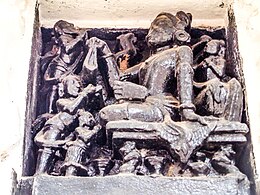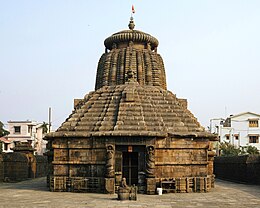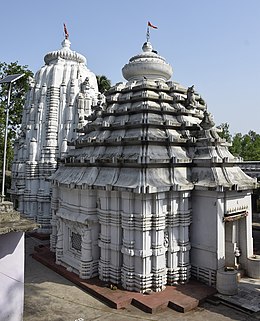
Jagannatha is a deity worshipped in regional Hindu traditions in India as part of a triad along with his (Krishna's) brother Balabhadra, and sister, Subhadra. Jagannath, within Odia Hinduism, is the supreme god, Purushottama, and the Para Brahman. To most Vaishnava Hindus, particularly the Krishnaites, Jagannath is a form of Krishna, sometimes as the avatar of Vishnu. To some Shaiva and Shakta Hindus, he is a symmetry-filled tantric form of Bhairava, a fierce manifestation of Shiva associated with annihilation.

Kalinga is a historical region of India. It is generally defined as the eastern coastal region between the Ganges and the Godavari rivers, although its boundaries have fluctuated with the territory of its rulers. The core territory of Kalinga now encompasses all of Odisha and some part of northern Andhra Pradesh. At its widest extent, the Kalinga region also included parts of present-day Chhattisgarh, extending up to Amarkantak in the west. In the ancient period it extended until the bank of the Ganges river.

Boudh District is an administrative and municipal district, one of thirty in the Odisha, India. The district headquarters is the city of Boudh.

The history of Odisha begins in the Lower Paleolithic era, as Acheulian tools dating to the period have been discovered in various places in the region. The early history of Odisha can be traced back to writings found in ancient texts like the Mahabharata, Maha Govinda Sutta and some Puranas. The region was also known to other kingdoms in region of East Indies due to maritime trade relations.
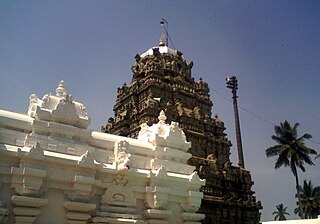
Sri Kurmam also known as Srikurmu or Srikurmais a village near Srikakulam, Andhra Pradesh, India. Srikurmam village is situated at a distance of 14.5 km to the South-east of Srikakulam town. It is in the Gara mandal of Srikakulam district. The village was named after the Srikurmam temple dedicated to Kurma avatar of the Hindu god Vishnu, which was re-established by Eastern Ganga Dynasty King Anantavarman Chodaganga Deva.

The Gajapati dynasty, also called the Suryavamsa dynasty was a medieval Hindu dynasty in the Indian subcontinent, originally from the region of Trikalinga that reigned from c.1434 to 1541. At its peak, it ruled over an empire stretching from the Ganges in the north to the Kaveri in the south, comprising large parts of Andhra Pradesh and some parts of western regions of West Bengal. It succeeded the Eastern Gangas.The Gajapati dynasty was founded by Kapilendra Deva who was of Suryavamsa lineage after the death of the last ruler of Eastern Ganga Dynasty Bhanu Deva IV. Their Capital was Kataka.
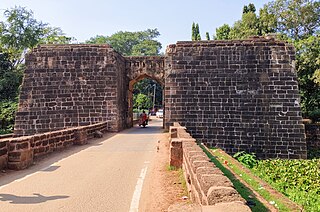
Barabati Fort is a 987 CE fort built by Marakata Keshari of Somavanshi (Keshari) dynasty in Cuttack, Odisha. The ruins of the fort remain with its moat, gate, and the earthen mound of the nine-storied palace.
Western Odisha is the western part of the state of Odisha in India, extending from the Kalahandi district in the south to the Sundargarh district in the north.

The Eastern Ganga dynasty were a large medieval era Indian royal Hindu dynasty that reigned from Kalinga from as early as the 5th century to the mid 20th century. Eastern Gangas ruled much of the modern region of Odisha in three different phases by the passage of time, known as Early Eastern Gangas (493–1077), Imperial Eastern Gangas (1077–1436) and Khemundi Gangas (1436–1947). They are known as "Eastern Gangas" to distinguish them from the Western Gangas who ruled over Karnataka. The territory ruled by the dynasty consisted of the whole of the modern-day Indian state of Odisha, as well as major parts of north Andhra Pradesh, parts of Chhattisgarh and some southern districts of West Bengal. Odia language got official status in their regime following the evolution of the language from Odra Prakrit. The early rulers of the dynasty ruled from Dantapuram; the capital was later moved to Kalinganagara, and ultimately to Kataka and then to Paralakhemundi.

Gajapati Langula Narasingha Deva I was an Eastern Ganga monarch and a warrior of the Kalinga region who reigned from 1238 CE to 1264 CE. He defeated the Muslim forces of Bengal who constantly threatened the Eastern Ganga dynasty's rule over his kingdom of Kalinga from the times of his father Anangabhima Deva III. He was the first king from Kalinga and one of the few rulers in India who took the offensive against the Islamic expansion over India by Turko-Afghan invaders of Eastern India. His father had successfully defended his kingdom against the Turko-Afghan rulers of Bengal and crossed into Rarh, Gauda and Varendra in Bengal chasing the invaders on backfoot. He became the dominant ruler of the peninsula by defeating the Turko-Afgan, Gouda, and the powerful monarch of the south kakatiya Dynasty king Ganapati Deva, and was one of the most powerful Hindu rulers in India. He also built the Konark temple to commemorate his victories over the Muslims as well as other temples and the largest fort complex of Eastern India at Raibania in Balasore. He also built famous Varaha Lakshmi Narasimha Temple at Simhachalam, Andhra Pradesh. The Kendupatana plates of his grandson Narasingha Deva II mention that Sitadevi, the queen of Narasingha Deva I was the daughter of the Paramara king of Malwa.
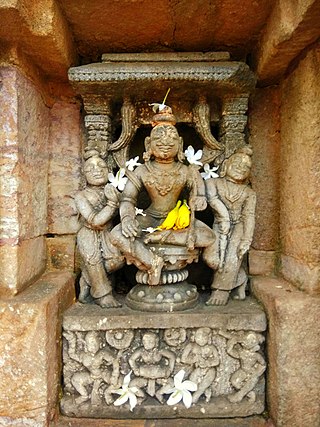
Kapilendra Deva was the founder of the Suryavamsa Gajapati dynasty that ruled parts of eastern and southern India with the present-day Odisha as the center of the kingdom. He ascended to the throne after staging a military coup against the preceding and the last ruler from the Eastern Ganga dynasty, Bhanudeva IV.

Vira Pratapa Purushottama Deva was the second ruler from the Suryavamsa Gajapati dynasty. His father Gajapati Kapilendra Deva Routaraya chose him as his heir to rule the Gajapati Kingdom at the banks of river Krishna where he breathed his last. This decision infuriated his elder brother Hamvira Deva who was a battle hardened and successful warrior fulfilling the task of conquering the southern territories and expeditions against the Vijayanagara Empire as wished by his father.

The Kalachuris of Ratnapura, also known as the Haihayas of Ratanpur, were a dynasty that ruled in Central India during the 12th and 13th centuries. They ruled parts of present-day Chhattisgarh from their capital at Ratnapura. They were an offshoot of the Kalachuris of Tripuri, and ruled as vassals of the parent dynasty for many years.

Prataparudra Deva was the third Gajapati emperor of Odisha from the Suryavamsa Gajapati Empire founded by his grandfather Kapilendra Deva. He reigned from 1497 to 1540 CE. Besides being a monarch, he was a devout Vaishnava and adherent of the famous saint, Sri Chaitanya who arrived in Odisha during his reign. His life was extremely occupied with overwhelming military campaigns in defense of his inherited territory from three frontal invasions by the enemy states Vijayanagar, Hussain Shahi dynasty of Bengal and Turko-Persian Qutb Shahi dynasty of Golconda. He lost large portions of his territory to the neighboring enemy states initiating the dissolution of Odisha's military hegemony and imperial status that continued for nearly a period of 600 years before him.
Maharaja Sivakara Deva I or Sivakara Unmattasimha/Unamattakeshari was a powerful monarch of the Bhaumakara dynasty who ruled in the late tertiary part of the 8th century A.D. He was the descendant of Ksemankara Deva who is believed to be the founder of the Bhaumakara rule in ancient Odra and also the earliest organizer of the Varna system in the region. Sivakara Deva I pursued a career of conquest in the eastern part of India establishing the Bhaumakaras as the supreme power in the whole region during his lifetime. According to the Talcher plate of Sivakaradeva III, Sivakaradeva I alias Unmattasimha defeated the king of Radha(south-West Bengal). When Unmattasimha was ruling in Orissa, Bengal was still in a state of disorder, and therefore the Radha king defeated by him can not be identified. However, Sivakara I either started ruling from 756 CE or 786 CE. He subjugated the Eastern Ganga rulers of Kalinga as his vassals. His dominions stretched from the border of Bengal in the north to the river Godavari in the south. He was a devout Buddhist who in 790 built the Sholampura Buddha Vihara and who adopted the epithets of Paramopasaka and Paramatathgata meaning a devout worshiper of Buddha which has been mentioned in the Neulpur charter of the Bhaumakaras. He sent a Buddhist scholar as an emissary to the Chinese emperor Te-tsong or Dezong with valuable Mahayana Buddhist manuscripts and established a new era of maritime trade and cultural relationship between ancient Odisha and China.
Prithvi-deva II was one of the most powerful Ratnapura Kalachuri kings, who ruled over the present-day Indian state of Chhattisgarh. His reign is placed 1135–1165 CE.

The Bhoi dynasty or the Yaduvamsa dynasty were a medieval Hindu dynasty from the Indian subcontinent, which originated in the region of Odisha that reigned from 1541 to 1560 CE. Govinda Vidyadhara had usurped the throne from the later weaker Suryavamsa Gajapati Empire rulers as the kingdom started weakening but had a short-lived reign as ruling chiefs of Odisha as the ensuing internal rivalries and constant threats of invasions rendered them weak and were eventually overthrown by Mukunda Deva of Chalukya Dynasty in 1560.

The Chindaka Nagas were a dynasty that ruled over parts of modern-day Odisha and Chhattisgarh. Their kingdom was known as Chakrakota mandala and included the present-day districts of Bastar, Koraput and Kalahandi. They were constantly at war with their neighbours- the Somavamshi dynasty, the Kalachuris of Ratnapura, the Mana dynasty and the Western Chalukya Empire.
The Battle of Katasin was fought in 1243 CE between Narasingha Deva I of the Eastern Ganga dynasty and Tughral Tughan Khan, the Bengal governor of the Mamluk dynasty of Delhi, at Katasin. Narasingha Deva I delivered a crushing defeat to the Mamluk forces and subsequently went on to capture additional territory.



